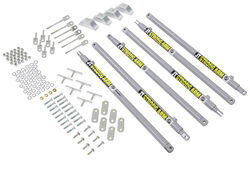
Where Does JT Strong Arm # LC191025 Install on a Travel Trailer
Question:
Where do you put the two bar set-up on the rear or front jacks of a travel trailer? The only info I can find is on 5th wheels which show the 2 bar set-up on the front landing gear. Can you advise for a travel trailer?
asked by: Cody
Expert Reply:
Basically you can install the JT Strong Arm # LC191025 on any jack on a travel trailer other than the tongue jack. Below I have included the text of the instructions:
1. Determine what style of jacks are on the chassis.
2. Locate a cross-member rearward of the rear jacks at a minimum of 4” to a maximum of 18” for jacks mounted at an angle. For jacks mounted square with the chassis frame, use a minimum of 6”.
3. Under front half of chassis, locate a cross-member or center compartment with a steel floor from 6”-18” from front of front jacks.
4. Starting with one of the front scissor jacks, remove the existing lower, inside pivot bolt; replacing with a 3/8” x 4” swing-bolt. Install swing-bolt from front-to-back with the shoulder of the swing-bolt to the front side of jack. Place 3/8” washer and 3/8”-16 “Nylock” locking nut on threaded end of swing-bolt. Tighten enough so that the swing-bolt will only pivot by using a screwdriver for leverage. Ensure swing-bolt tab is positioned horizontally.
5. Remove the existing lower, outside pivot bolt; replacing with 5” swing-bolt. Install swing bolt from rear-to-front with shoulder of swing-bolt to rear of the jack.
6. Place a 3/8” washer and 3/8” locking nut on threaded end of swing-bolt and tighten as explained in Step 4. Position swing-bolt tab vertically.
7. Repeat Steps 4-6 for opposite front jack.
8. Apply white grease to the threads of two “T”-bolts and partially thread them into the top holes of the outer stabilizer tubes.
9. Remove inner stabilizer tube from assembly and discard the plastic shipping bag. Reassemble stabilizer tubes with the inner tube sticking out past the end of the outer tube by 1”.
10. Tighten “T”-bolts until snug. To ensure proper installation, make sure the warning labels are facing outward and right-side up. The “T”-bolts should also be on the top side of the stabilizers. Repeat Steps 9 and 10 for opposite side.
11. After fully retracting front scissor jacks, attach the clevis end of the stabilizer inner tube to the swing-bolt tab on the front side of the jack using a 3/8”-16 x 1 ½” bolt with a 3/8” washer on the top and bottom of the tab and a 3/8” locking nut. Tighten nut until tight. Repeat this step on the opposite side.
12. Insert a 3/8” x 1 1/4” swing-bolt into a spacer mount and secure with a 3/8” washer and 3/8” locking nut. Attach assembled spacer mount to clevis end of the stabilizer outer tube using a 3/8”-16 x 1 ½” bolt and a 3/8” washer on both sides of the clevis. Tighten a 3/8” locking nut enough to allow the stabilizer to swivel by hand with some resistance. Repeat this step for the opposite side.
13. Swing stabilizer toward the center of the chassis and up to the cross-member identified in Step 3. Ensure that the front of the spacer mount is parallel to front of cross-member and the mounting holes are centered front-to-back on the cross-member. With the spacer mount held against the cross-member, mark the mounting hole locations with a marker. Center punch each location. Drill a 1/8” pilot hole at each mounting hole location. Drill out one of the mounting holes to 5/16” and tap either using a 3/8”-16 tap or a 3/8”-16 x 1” self-tapping bolt. Lubricate as needed. Remove tap or bolt and secure spacer mount with a 3/8”-16 x 1” self-tapping bolt, taking care to keep the remaining pilot hole centered in the mounting hole of the spacer mount. Tighten bolt securely. Drill remaining pilot hole to 5/16” and insert a 3/8”-16 x 1” self-tapping bolt and tighten. Repeat this step for opposite side.
NOTE: For chassis that are constructed with “I” or “H” beam main rails (front-to-back) and are uninsulated, refer to Step 14. For chassis that are constructed with “I” or “H” beam main rails or tubular frames and/or insulated, refer to Step 15.
14. Measure from the rear side of the front scissor jack 30” and place a mark on the bottom of the main rails. Measure the bottom flange of the main rails and divide by 4 for center of mounting hole. Center punch at the intersection of the lines and drill an 1/8” pilot hole. Drill out the pilot hole to 3/8” and deburr. Secure a stiffening pad to bottom of the main rail flange using a 3/8” x 1 ¼” swing-bolt, a 3/8” washer, and a 3/8” locking nut. The edge of the stiffening pad should be parallel to the edge of the main rail flange. Drill remaining mounting hole and secure with a 3/8”-16 x 1 ½” bolt, 3/8” washer, and 3/8” locking nut. Repeat this step for opposite side.
15. Measure from the rear side of the front scissor jack 27-3/4” and place a mark on the bottom of the main rails. Assemble a spacer mount as in Step 12. Using the spacer mount as a template, mark the mounting holes by aligning one short edge with the 27 ¾” mark. Ensure the spacer
mount is parallel to the outside of the main rail flange. Center punch and drill an 1/8” pilot holes at each mounting hole location. Drill out the hole closest to the front jacks to 5/16” and tap using either a 3/8”-16 tap or 3/8”-16 x 1” self-tapping bolt. Lubricate as needed. Secure spacer mount to bottom of main rail flange with a 3/8”-16 x 1” self-tapping bolt, taking care to keep the remaining pilot hole centered in the mounting of the spacer mount. Tighten bolt securely. Drill the remaining pilot hole out to 5/16” and insert a 3/8”-16 x 1” self-tapping bolt and tighten. Repeat this step for opposite side.
16. Prepare “T” bolts as described in Step 8. Remove inner stabilizer tube from assembly and discard plastic shipping bag. Reassemble stabilizer tubes with the inner tube sticking out past the end of the outer tube by 5”. Tighten “T” bolts until snug. To ensure proper installation, make sure
the warning labels are facing outward and right-side up. The “T”-bolts should also be on the top side of the stabilizers. Attach the clevis end of the stabilizer inner tube to the swing-bolt tab on the rear side of the jack using a 3/8”-16 x 1 ½” bolt with a 3/8” washer on the top and bottom of the
tab and a 3/8” locking nut. Tighten nut until tight. Repeat this step on the opposite side.
17. Starting with one of the rear scissor jacks, remove the existing lower, outside pivot bolt; replacing with a 3/8” x 4” swing-bolt. Install swingbolt from back-to-front with the shoulder of the swing-bolt to the rear side of jack. Place 3/8” washer and 3/8”-16 locking nut on threaded end
of swing-bolt. Tighten enough so that the swing-bolt will only pivot by using a screwdriver for leverage. Ensure swing-bolt tab is positioned horizontally.
NOTE: If scissor jacks are less than 2” wide, washers will be necessary on the swing bolt because the threads may not be long enough.
18. Prepare “T” bolts and stabilizer tubes as described in Steps 8-10. Repeat for opposite side.
19. After fully retracting rear scissor jacks, attach the clevis end of the stabilizer inner tube to the swing-bolt tab on the rear side of the jack using a 3/8”-16 x 1 ½” bolt with a 3/8” washer on the top and bottom of the tab and a 3/8” locking nut. Tighten nut until tight. Repeat this step on the opposite side.
NOTE: For chassis that are constructed with “C” channel rear cross-members and uninsulated, refer to Step 20. For chassis that are constructed with “C” channel rear cross-members or tubular frames and/or insulated, refer to Step 21.
20. Attach a 3/8” x 1 ¼” swing-bolt to the clevis end of the stabilizer outer tube with a 3/8”-16 locking nut and 3/8” washers. Tighten nut enough to allow the swing-bolt to point upwards. Rotate stabilizer tube toward center of chassis and up to cross-member identified in Step 2. Mark where
center of swing-bolt meets the center of the cross-member front-to-back on the bottom of the cross-member. Align a stiffening pad with the outer hole centered on the mark for the center of the swing-bolt. Clamp the stiffening pad to the cross-member with a pair of locking pliers and drill mounting holes with a 3/8” bit. Secure stiffening pad to the cross-member with a 3/8” x 1 ¼” bolt, 3/8”-16 locking nut, and 3/8” washer in the inside mounting hole. After removing the locking pliers, attach swing-bolt to remaining mounting hole with a 3/8” locking nut and washer. Repeat step for opposite side.
21. Prepare spacer mount as described in Step 12. Rotate stabilizer tubes toward center of chassis and upward to cross-member identified in Step 2. Using the spacer mount as a template, mark the mounting holes by aligning one short edge with the center of the cross-member. Ensure the
spacer mount is parallel to the edge of the rear cross-member. Center punch and drill an 1/8” pilot hole at each mounting hole location. Drill out the hole closest to the rear jacks to 5/16” and tap using either a 3/8”-16 tap or 3/8”-16 x 1” self-tapping bolt. Lubricate as needed. Secure spacer
mount to bottom of rear cross-member with a 3/8”-16 x 1” self-tapping bolt, taking care to keep the remaining pilot hole centered in the mounting of the spacer mount. Tighten bolt securely. Drill the remaining pilot hole out to 5/16” and insert a 3/8”-16 x 1” self-tapping bolt and tighten. Repeat this step for opposite side.

Product Page this Question was Asked From
JT's Strong Arm Jack Stabilizer Kit for Travel Trailers
- Camper Jacks
- Travel Trailer
- Stabilizer Jacks
- Steel
- 6 Jacks
- Lippert
more information >
Featured Help Information
Instructions

Continue Researching
- Shop: JT's Strong Arm Jack Stabilizer Kit for Travel Trailers
- Search Results: x chock
- Search Results: strong arm
- Search Results: wheel chock
- Q&A: Will JT's Strong Arm Jack Stabilizer Kit Fit a 2019 Jayco Jay Flight 32BHDS with Heated Underbelly?
- Shop: RV Camera
- Q&A: Lug Nut Torque Chart for Trailer Wheels
- Article: Trailer Wiring Diagrams
- Shop: Trailer Hitch
- Shop: Furrion Vision S Wireless RV Backup Camera System w/ Night Vision - Rear Mount - 5" Screen
- Search Results: trailer jack
- Search Results: trailer brake controller
- Article: Trailer Tire Sizing
- Shop: Tekonsha Prodigy P3 Trailer Brake Controller - 1 to 4 Axles - Proportional
- Q&A: What is The Thickness Of The 4-Leaf Double-Eye Spring # e47SR?
- Shop: Trailer Wiring
- Shop: Suspension Enhancement
- Search Results: spare tire carrier
- Q&A: Availability of Additional Go Power 200 Watt Solar Panels
- Video: Choosing the Right Trailer Wiring
- Article: Most Popular Wheel Bearings
- Shop: etrailer Hitch Pin Alignment Collar for Hitch Accessories - 2" Hitches
- Shop: Universal Installation Kit for Trailer Brake Controller - 7-Way RV and 4-Way Flat - 10 Gauge Wires
- Article: Brake Controller 7- and 4-Way Installation Kit (ETBC7)
- Search Results: equalizer
- Shop: Brake Controller
- Shop: Hub Bearing Kit for Lippert, Dexter, and AL-KO Axles - 3,500 lb with #84 Spindle
- Article: Wiring Trailer Lights with a 7-Way Plug (It's Easier Than You Think)
- Shop: Fifth Wheel Hitch
- Article: How to Measure Your Trailer Wheel Bolt Pattern

























